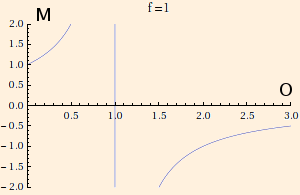
Optics
- In optics,
- I is the image distance,
O is the object distance,
f is the focal length and R is the
radius of curvature of a spherical lens or mirror.
- R is positive for lenses (and negative for mirrors) if the center of curvature is on the
opposite side of the light from the object.
- For a flat surface, R = ∞.
- The magnification M = - I / O, which also equals - image size / object size. If M < 0, the image is inverted.
I and f are positive for lenses (and negative for mirrors) if they are on the opposite side of the lens or mirror from the light from the object:

| converging lens | diverging lens |
| I > 0 | I < 0 |
| Renter > 0 | Renter < 0 |
| Rexit < 0 | Rexit > 0 |
| f > 0 | f < 0 |
| M < 0 | M > 0 |
| real image | virtual image |
- 1 / I + 1 / O = 1 / f.
This is called the thin lens equation.
Combining it with the definition of magnification, we find that
M = f / (f - O)
 This means that for negative f (diverging lenses and convex mirrors), 0 < M < 1.
This means that for negative f (diverging lenses and convex mirrors), 0 < M < 1.
It also means that for positive f (converging lenses and concave mirrors),
- if O < f, M > 1;
- as O → f -, M → ∞;
- for O > f, M < 0;
- as O → f +, M → -∞;
- when O = 2 f, M = -1; and
- as O → ∞, M → 0.
-
1 / f = 2 / R for a mirror.
-
1 / f = (n - 1) (1 / Renter - 1 / Rexit) for a lens in air.
This is called the lens maker's equation.
If f in measured in meters, s = 1/f is the lens strength measured in diopters.
For compound lenses, the strengths are additive.
- For light refracting from medium 1 to medium 2 through a spherical surface of radius R,
n2 / I + n1 / O = (n2 - n1) / R.
©2011, Kenneth R. Koehler. All Rights Reserved. This document may be freely reproduced provided that this copyright notice is included.
Please send comments or suggestions to the author.
